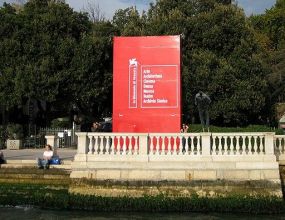 AlMare, CC BY-SA 2.5 - Wikimedia Commons.
AlMare, CC BY-SA 2.5 - Wikimedia Commons. The opening of the first Roma Pavilion at the 52nd Venice Biennale 2007, which was commissioned by the European Roma Institute for Arts and Culture (ERIAC) and organized by the Open Society Institute, Allianz Kulturstiftung, and the European Cultural Foundation, marked a turning point in the history of art. By presenting a curated selection of contemporary Roma artists from different parts of the world, this event paved the way for Roma culture to finally get recognition on the global art scene.
The creation of the Roma Pavilion was the result of an important initiative by the Open Society Institute’s Arts and Culture Network Program, in order to find undiscovered talents within the Roma community. The aim of the program was to discover Roma artists who, until then, were mainly unknown to the broader European art world. Through collaboration with various organizations, institutions, and individuals who had already been working to promote fair representations of Roma culture, the initiative succeeded in bringing to light the rich and diverse artistic community of the Roma people.
The exhibition, titled "Paradise Lost," featured the works of 16 Roma artists, including Daniel Baker, Tibor Balogh, Mihaela Cimpeanu, Gabi Jiminez, András Kallai, Damian Le Bas, Delaine Le Bas, Kiba Lumberg, Omara, Marian Petre, Nihad Nino Pušija, Jeno André Raatzsch, Dušan Ristić, István Szentandrassy, Norbert Szirmai and János Revesz. The aim of the Pavilion was not only to present their art but also to fight the stereotypes and misconceptions about Roma culture that have been around in Europe since the 19th century. The Pavilion exhibition allowed to place Roma artists on an equal footing with others in the international art world, at the same time destroying the exoticized and often disparaging images of Roma people that have been prevalent in European art and culture. World renowned film director Wim Wenders sees the Pavilion as an opportunity “to correct our image of the largest minority in Europe, which is still shaped by Gypsy romance and Gypsy kitsch.”
The Pavilion opened on June 7, 2007, with a big celebration. In the first three weeks of its operation, over 3,000 people visited the Pavilion, giving contemporary Roma artists a platform to present their work to a global audience. Among the distinguished guests were European policymakers and cultural leaders, including Viktoria Mohacsi, Member of the European Parliament; Dzamila Stehlikova, Czech Minister of Human Rights and National Minorities; and George Soros, Chairman of the Open Society Institute.
After the launch, a panel discussion led by BBC correspondent Nick Thorpe explored the important issues related to the creation of a separate Roma Pavilion. Participants, including the exhibition’s curator, Timea Junghaus, discussed whether or not such a specific place was required or if it risked further marginalization. “Without a dedicated Roma Pavilion, it would be impossible to introduce Roma artists to the international scene, because they do not have access to the necessary infrastructure,” argued Timea Junghaus.
The Pavilion also featured performances that explored themes of resistance, identity, and the role of Roma women in challenging patriarchal structures. These performances, along with the exhibition, emphasized the Pavilion’s broader mission: to foster a positive perception of Roma identity, stimulate self-confidence within the Roma community, and challenge the long-held negative stereotypes that have been associated with Roma people.
The success of the Roma Pavilion at the Venice Biennale was not just a triumph for the artists involved but also a significant step forward in the ongoing struggle for Roma inclusion and equal rights in Europe. By presenting contemporary Roma culture in such a prestigious and visible venue, the Pavilion sent a powerful message of inclusion and recognition.
As the first Roma Pavilion demonstrated, cultural work can be a powerful tool in revealing social injustices and promoting positive change. The exhibition’s success laid the groundwork for future Roma-focused exhibitions and underscored the need for continued efforts to support and promote Roma culture within the European and global contexts.
In the years following the inaugural Roma Pavilion, there has been a growing recognition of Roma art and culture, with subsequent exhibitions at the Venice Biennale and other major international art events. The Pavilion’s legacy continues to influence the discourse on Roma identity, culture, and inclusion, highlighting the ongoing need for spaces that celebrate and support the diverse voices within the Roma community.